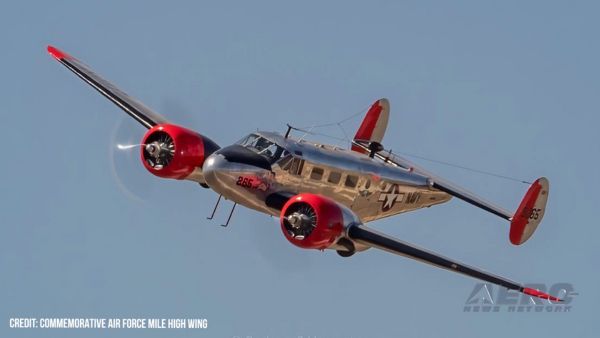Fri, Aug 23, 2013
Tests Conducted In Collaboration With The FAA, Army, Navy
NASA researchers will drop a 45-foot-long helicopter fuselage from a height of about 30 feet to test improved seat belts and seats and advance experimental techniques and crashworthiness data. NASA is collaborating with the U.S. Navy, U.S. Army and Federal Aviation Administration on the Transport Rotorcraft Airframe Crash Test Bed full-scale crash tests at Langley's Landing and Impact Research Facility.

"We have instrumented a former Marine helicopter airframe with cameras and accelerometers," said lead test engineer Martin Annett. "Almost 40 cameras inside and outside the helicopter will record how 13 crash test dummies react before, during and after impact."
During the test, onboard computers will record more than 350 channels of data as the helicopter is swung by cables, like a pendulum, into a bed of soil. Just before impact, pyrotechnic devices release the suspension cables from the helicopter to allow free flight. The helicopter will hit the ground at about 30 mph. The impact condition represents a severe but survivable condition under both civilian and military requirements. For the first time ever in any test, technicians installed a video game motion sensor in the helicopter. "We want to see if it is useful as an additional way to track the movements of the dummies," said test engineer Justin Littell.
The outside of the fuselage also is new for this test. Technicians painted one entire side in black polka dots over a white background -- a photographic technique called full field photogrammetry. Each dot represents a data point. High-speed cameras filming at 500 images per second track each dot, so after over the drop researchers can plot and see exactly how the fuselage buckled, bent, cracked or collapsed under crash loads.
Another crash test of a similar helicopter equipped with additional technology, including composite airframe retrofits, is planned for next year. Both tests are part of the Rotary Wing Project in the Fundamental Aeronautics Program of NASA's Aeronautics Research Mission Directorate.
The Navy provided the CH-46 Sea Knight helicopter fuselages, seats, crash test dummies and other experiments for the test. The Army contributed a litter experiment with a crash test dummy. The Federal Aviation Administration provided a side-facing specialized crash test dummy and part of the data acquisition system. Cobham Life Support-St. Petersburg, a division of CONAX Florida Corporation, also contributed an active restraint system for the cockpit.
NASA will use the results of both tests in efforts to improve rotorcraft performance and efficiency, in part by assessing the reliability of high performance, lightweight composite materials. Researchers also want to increase industry knowledge and create more complete computer models that can be used to design better helicopters. The ultimate goal of NASA rotary wing research is to help make helicopters and other vertical take-off and landing vehicles more serviceable -- able to carry more passengers and cargo -- quicker, quieter, safer and greener. Improved designs might allow helicopters to be used more extensively in the airspace system.
More News
Also: 787-Billion Pax, Ryanair Buying Chinese, Ballooning HoF, ERAU MX Competition An NTSB Preliminary report is shedding some light on the Rob Holland tragedy. And there now seems>[...]
Also: Tricky Golf Course Deadstick, Textron Special Olympics, Artemis II, FlightSimExpo! Stratolaunch conducted the second successful launch and recovery of its Talon-A2 autonomous>[...]
Also: Rotax Service Instruction, LAA Jabiru Alert, New AMA Boss, FlightSimExpo ANN’s Jim Campbell got an hour in the SLEEK Blackshape Prime last week along with a chance to w>[...]
“Secretary Duffy’s plan cements America as a global leader in aviation, investing in both technology and the air traffic control workforce to enhance U.S. aviation safe>[...]
Witnesses Described That The Glider Pitched Up Before Entering A Nose Low, Left Descending Turn Analysis: The 84-year-old pilot was being towed for takeoff in his glider when the a>[...]
 Airborne 05.05.25: NTSB Holland Prelim, Airlines v Tariffs, $$$ For ATC
Airborne 05.05.25: NTSB Holland Prelim, Airlines v Tariffs, $$$ For ATC Airborne 05.07.25: Talon A-2 Hypersonic, FIFI Under Repair, Spirit Furloughs
Airborne 05.07.25: Talon A-2 Hypersonic, FIFI Under Repair, Spirit Furloughs Airborne Affordable Flyers 05.08.25: Blackshape Test, Risen, Alto NG Sells Out
Airborne Affordable Flyers 05.08.25: Blackshape Test, Risen, Alto NG Sells Out Aero-News: Quote of the Day (05.11.25)
Aero-News: Quote of the Day (05.11.25) NTSB Final Report: Schleicher Alexander GMBH & CO ASH 26 E
NTSB Final Report: Schleicher Alexander GMBH & CO ASH 26 E



